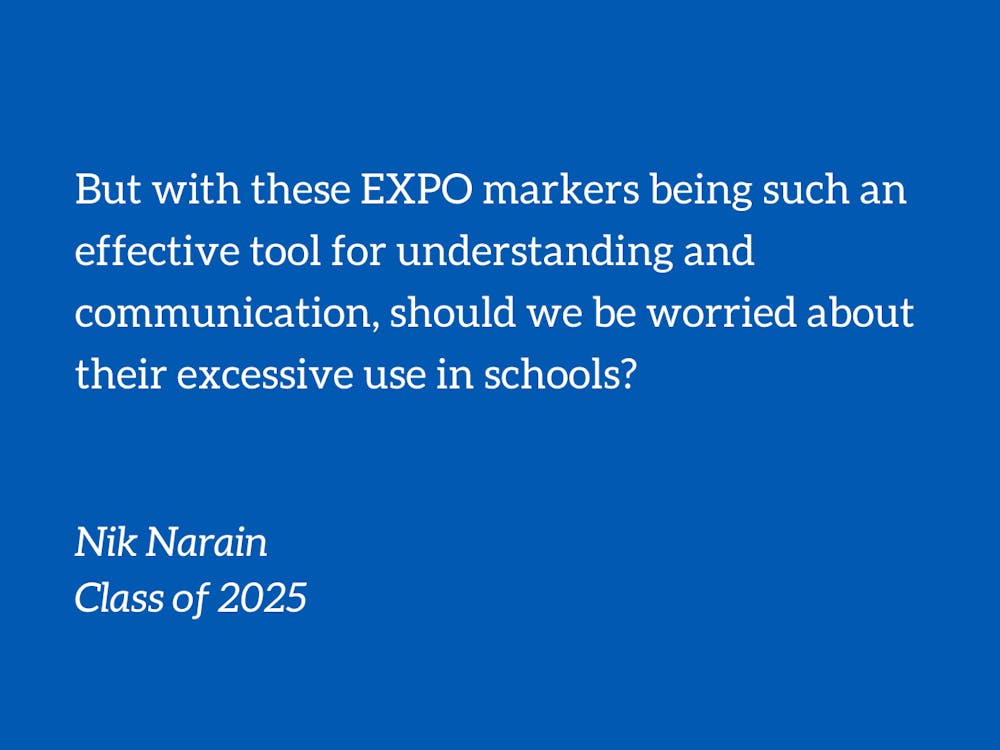EXPO markers are an essential part of our education. For years, the way in which we’ve learned practically every subject has involved some adult, presumably with a teaching degree, writing information on a whiteboard, erasing it, and hoping that we remember it all. Of course, at Duke, that teaching model is no different — unless you’re a math or physics major, in which you now probably have a thin layer of yellow chalk in your lungs.
Even outside of class, we use EXPO markers for a variety of tasks — club meetings, study sessions, to-do lists, and the occasional lighthearted classroom vandalism (so that everybody knows who “wuz here”). In fact, some estimate that we use up to 400 or even 500 million whiteboard markers a year. But with these pungent pens being such an “effective tool for understanding and communication,” should we be worried about their excessive use in schools?
Dry-erase markers were invented by Jerry Woolf of Techform Laboratories and later patented by the Pilot Pen stationery company in 1975. The Sanford Ink Company came out with their own dry-erase marker in 1976 called “EXPO,” and these markers grew popular in the U.S. throughout the 90s as a cleaner alternative to chalk. Interestingly, the whiteboard had already existed for over 30 years, mainly serving as a canvas for wet-erase markers, which had also been around for decades.
The design of dry-erase markers hasn’t changed too much since the original prototype. Every marker typically has three main ingredients: a carrier, some pigments, and a resin. The carrier is a water or alcohol-based solvent that helps carry the ink to the surface of the tip, and the pigments are what give the ink its distinctive color profile. But what separates dry-erase markers from other writing tools is their oily silicone-based polymer resin. This makes the ink “slippery” so that the pigments can adhere to the whiteboard but don’t actually bind with the surface. And unlike paper, whiteboards are nonporous, so the dry-erase ink only remains on the outermost layer of the board. That’s why dry-erase ink on a whiteboard or even glass can be easily wiped off with an eraser, paper towel, or a greasy hand.
Some organizations criticize EXPO markers for their potentially toxic effects, namely due to their high concentrations of volatile organic compounds (VOCs). VOCs simply refer to a group of chemicals that can vaporize into the air, and they’re found in a variety of household products. However, some VOCs are known to cause eye irritation, headaches, dizziness, and respiratory issues if inhaled in large quantities or absorbed through the skin. Most of the VOCs found in dry-erase markers are usually from the alcohol-based solvent, like diacetone alcohol or butanol, and other VOCs like xylene contribute to the distinctive marker smell. One study reported that dry-erase markers contain 400 times the VOC emissions as washable markers or highlighters, on par with the emissions of Sharpies, which, let’s just say, was the easiest way to get high in the third grade.
As a result, groups like the Healthy Schools Network have recommended that schools don’t use permanent or dry-erase markers at all, especially around young children, who we can all agree do not need to be any more volatile and irritating to the eye. Nevertheless, it’s important to note that not all VOCs are harmful, and no studies have directly correlated EXPO markers themselves with serious health effects. Perhaps more practical recommendations, as put forth by the Seattle government in 2008, are to opt for water-based markers instead of alcohol-based ones, to choose markers labeled as “low-odor” or “low-VOC”, and to avoid scented markers, which contain higher amounts of xylene. Avoid art products that contain the “HL” or “CL” seal, which identifies products that contain a carcinogen, neurotoxin, or developmental toxicant, and look for ones with the “AP Non-toxic” seal instead. And most importantly, don’t huff EXPO markers, because you’re just going to get a headache, and you look really stupid doing it.
But what’s arguably most concerning about these markers are their environmental effects. EXPO markers can’t be recycled as they’re made of non-recyclable plastic, and the ink insert would burn up during the recycling process. If every marker contains about 20 grams of plastic, and we throw out 400 million a year, you don’t need to do the math to know that’s a lot of plastic. Moreover, almost all VOCs directly contribute to global warming by reacting with nitric oxides in the air to form ozone or smog. Thus, not only will every dry-erase marker end up in a landfill, but its components play a considerable role in greenhouse gas emissions.
Again, there’s no definitive evidence that EXPO markers are a direct cause of cancer or climate. But when we break down their components, it’s clear to see that their use has a profound impact on matters that, at the very least, are far more important than the physics midterm I bombed a few weeks ago. Luckily, companies like AusPen are creating refillable marker alternatives that are affordable, recyclable, and can last up to 15 years. Even household brands like Pilot Pen have refillable varieties of their office supplies.
To be fair, a small change like using refillable markers is not going to solve larger climate issues that many scientists, professors, and students at Duke work on every day. But hey — if Duke can’t divest from fossil fuels, maybe we can at least use some more eco-friendly supplies in the classroom.
Nik Narain is a Trinity sophomore. His columns typically run on alternate Fridays.
Get The Chronicle straight to your inbox
Signup for our weekly newsletter. Cancel at any time.

